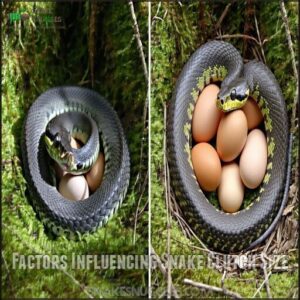This site is supported by our readers. We may earn a commission, at no cost to you, if you purchase through links.

Non-venomous snakes like garter snakes typically give birth to 10-40 live young, while venomous ones like rattlesnakes usually have smaller litters of 6-20.
Some snakes, like pythons, lay eggs instead, which can number from 20-100 or more in a clutch.
Factors like the snake’s age, size, and health, as well as environmental conditions, play a big role in determining the exact number.
Whether they lay eggs or have live births, snakes have fascinating ways of ensuring their offspring survive, and it is curious to learn about snake parenting methods; keep reading to find out more about these interesting creatures.
Table Of Contents
- Key Takeaways
- Snake Reproduction: Egg-Laying Vs. Live Birth
- Average Number of Offspring in Snake Clutches
- Factors Influencing Snake Clutch Size
- Breeding Seasons and Birth Timing for Snakes
- Snake Birthing Process and Maternal Care
- Survival Rates of Newborn Snakes
- Frequently Asked Questions (FAQs)
- How many babies can a snake have?
- How many babies do garter snakes give birth to?
- How many types of snakes give live birth?
- Do snakes lay eggs or give birth?
- How many babies do ovoviviparous snakes have?
- Do snakes give birth to live young?
- What is the Average Litter Size of a Snake?
- Are Snakes Born Live or From Eggs?
- How Does the Environment Affect Snake Reproduction?
- What is the Survival Rate of Baby Snakes?
- Conclusion
Key Takeaways
- Snakes can have anywhere from 1 to over 150 babies at a time, depending on the species and reproduction method.
- Smaller snakes usually have fewer offspring, while large ones like pythons or anacondas can produce massive clutches or litters.
- Live-birthing snakes, like garter snakes or boas, typically give birth to 10-40 babies, while egg-laying species can lay 20-100 eggs in a clutch.
- Factors like the snake’s size, age, health, and environment influence how many babies they’ll have.
Snake Reproduction: Egg-Laying Vs. Live Birth
Snakes reproduce in two main ways: laying eggs or giving live birth.
About 70% lay eggs, while the rest give birth to live young, with each method adapted to help the species survive its environment.
Oviparous Snake Species
Oviparous snakes, like ball pythons and Burmese pythons, are fascinating creatures that lay eggs instead of giving live birth. About 70% of all snake species are oviparous, showcasing diverse strategies to safeguard their eggs hatch safely.
Ball pythons and Burmese pythons highlight the diversity of oviparous snakes, protecting their eggs with uniquely adapted survival strategies.
Their clutch size varies widely, impacting hatchling survival and species growth. Nest site selection is vital for these snakes. Warm, hidden spots protect eggs from predators and extreme temperatures.
Some species actively guard their eggs, while others abandon their clutch after laying. Climate impacts reproduction, with tropical regions favoring egg-laying.
| Snake Species | Clutch Size | Incubation Days |
|---|---|---|
| Ball Python | 4-10 eggs | 55-60 days |
| Burmese Python | 20-50 eggs | 60-90 days |
| King Cobra | 20-40 eggs | 70-80 days |
Eggshell structure is remarkably delicate, yet strong enough to shield developing embryos, which is a remarkable adaptation for the survival of the species, and showcases the diversity of snakes.
Ovoviviparous Snake Species
Ovoviviparous species, like garter snakes and copperheads, nurture eggs inside their bodies until hatching.
This avoids risks like predators or harsh weather. Neonates arrive live and fully capable—think rattlesnake venom-ready!
| Feature | Oviparous Snakes | Ovoviviparous Snakes |
|---|---|---|
| Incubation Style | External Nest | Inside Mother |
| Hatchling Survival | Low | High |
| Notable Species | Sea Snake, Corn Snake | Rinkhals Cobra, Garter Snake |
Viviparous Snake Species
Unlike egg-layers, viviparous snakes bring snake babies into the world through live births, offering unique adaptations.
Their embryos rely on placental development for nutrients, enhancing survival.
Species like water snakes and boas vary in snake litter size based on habitat needs and gestation length.
| Snake Type | Litter Size (Avg.) | Unique Trait |
|---|---|---|
| Garter Snakes | 10-40 | Adapt well across habitats |
| Boas | 10-60 | Birth large, robust offspring |
| Anacondas | 20-50 | Benefit from aquatic adaptations |
| Water Snakes | 10-30 | Thrive in aquatic environments |
| White-Lipped Snakes | 5-15 | Suit cold climate conditions |
The table highlights the diversity in litter size and unique traits among different snake species, showcasing their adaptability to various environments.
Evolutionary Advantages of Different Reproductive Methods
Through clever reproductive strategies, snakes adapt to their environments to boost offspring survival.
Depending on climate adaptation and predation pressure, species opt for egg-laying (oviparous), live birth (viviparous), or a mix of both (ovoviviparous).
Egg-laying snakes produce large clutches, ideal for resource-rich habitats.
Meanwhile, live birth protects young in harsher climates or against predators.
Ovoviviparous snakes balance both, offering controlled conditions for development.
Climate and resource availability shape snake reproduction, ensuring genetic diversity through evolution.
| Reproductive Method | Key Traits | Survival Benefit |
|---|---|---|
| Oviparous | Large clutches | Maximizes offspring numbers |
| Viviparous | Internal development | Shields babies from threats |
| Ovoviviparous | Controlled environments | Balances energy and safety |
Average Number of Offspring in Snake Clutches
Snake reproduction brings incredible variety in terms of clutch size and litter size. Depending on the species, the average clutch size can range from just a few eggs to over a hundred offspring!
Here’s an overview of the fascinating ways snakes vary in their reproductive efforts:
- Tiny clutches: Brahminy blind snakes may only produce 1-2 offspring, focusing minimal energy on reproduction.
- Moderate numbers: Ball pythons typically lay 4-6 eggs, balancing large, healthy young with manageable clutch sizes.
- Bigger families: Corn snakes average 20-30 eggs, maximizing their species’ survival chances.
- Bumper broods: Reticulated or Burmese pythons can lay 100+ eggs, creating large clutches for population growth.
- Live bearers’ litters: Garter snakes produce about 10-50 live babies, ready to fend for themselves.
These differences in snake clutch size highlight how species adapt to environmental influence, maternal condition, and genetic impact, ensuring their offspring thrive. Some snakes are oviparous or egg-laying, while others bear live young.
Factors Influencing Snake Clutch Size
Regarding snake clutch sizes, many factors play a role, including the species and the mother’s age, size, and health.
The environment, genetic traits, and available food also influence how many eggs or babies a snake can produce.
Species-Specific Variations
Snake offspring vary greatly depending on the species, with clutch size and litter traits reflecting fascinating diversity.
Each species has its own unique rhythm in terms of reproduction.
For instance:
- Ball pythons: Lay smaller clutches of 3-14 eggs.
- Copperheads: Birth 3-10 live young after shorter gestation lengths.
- Corn snakes: Produce 10-30 eggs with minimal parental investment.
- Garter snakes: Deliver 20-40 live young, depending on geographic variation.
These variations highlight how environmental pressures, venomous litters, and snake reproduction strategies shape their offspring numbers.
Environmental Factors
Environmental factors like climate change and habitat loss shape snake reproduction.
Warmer temperatures boost development, but pollution impacts egg survival. Limited nesting spaces and food shortages force snakes to adjust clutch sizes.
When resources are scarce, fewer snake eggs are laid to improve survival chances.
A stable environment means healthier snake offspring, showing how critical nature’s balance is for clutch success.
Maternal Age and Size
A snake’s clutch size often mirrors its age first breeding and physical growth.
Larger, older females, with better maternal health, can handle higher energy demands, producing more snake babies in a litter.
Smaller, younger snakes typically have fewer due to limited resources.
This size clutch correlation connects lifespan and reproductive capacity, showing how age and size affect offspring size variation in snake reproduction and survival.
Nutritional Status of The Mother
A mother’s energy reserves directly affect her reproductive success.
Adequate nutrient allocation during the gestation period supports larger snake clutch sizes and healthier offspring. Poor dietary impact can shrink clutches and weaken the survival rate of snake eggs.
- **Well-fed mothers produce larger clutches, ensuring robust snake reproduction.
By prioritizing access to consistent prey, maternal energy reserves improve, enhancing the health of snake eggs and boosting reproductive success.
Genetic Factors
A snake’s clutch size often starts with its DNA.
Genetic diversity and heritability estimates shape its reproductive potential, determining how many eggs or live young it can produce.
Gene expression and mutation rates also play a role, occasionally causing variations in snake reproduction across species.
While environmental factors matter, natural limits on snake breeding are tied to trait inheritance, emphasizing how genetic factors shape clutch size in snake reproductive strategies, which is influenced by genetic diversity.
Breeding Seasons and Birth Timing for Snakes
Snake breeding seasons and birth timing vary widely depending on the species and environment.
While many snakes in colder regions mate in spring and give birth or lay eggs by fall, tropical species often breed year-round due to stable temperatures, which allows for year-round breeding activities.
Spring Mating and Fall Births
When spring awakens the world, snakes begin their mating rituals, setting the stage for seasonal reproduction.
Fall births guarantee hatchlings emerge when resources are abundant, increasing survival.
Snake reproduction responds to climatic influences like warmer springs and shifting seasons.
- Mating season peaks with spring’s warmth.
- Birth seasonality sees offspring in late summer or fall.
- Snake clutch size varies with maternal health, environment, and gestation length.
Everything aligns perfectly—or not!
Year-Round Breeding in Tropical Species
Thriving in tropical climates, many snakes breed year-round, thanks to constant temperatures and food abundance.
Species like the Burmese Python and Green Tree Python don’t rely on seasonal cues, adapting their reproductive cycles to match these ideal environments.
With no environmental barriers, their breeding frequency increases, ensuring survival despite evolutionary pressures.
Snake reproduction here features impressive clutch sizes, with snake reproductive timing aligned to available resources, making tropical regions essential for understanding snake breeding and offspring diversity.
Influence of Temperature on Breeding Cycles
Temperature shapes breeding like a maestro guiding an orchestra. Snakes adjust their timing based on seasonal shifts, ensuring survival. Climate change alters breeding ranges, driving species to adapt.
- Breeding thrives in certain ranges: Ideal temps are 18-30°C.
- **Too hot or cold?
** Breeding halts.
- Incubation temperature impacts development: Some species’ sex determination depends on warmth.
- Seasonal shifts prompt adjustments: Evolving climates force reproductive cycles to evolve.
Temperature and survival go hand in hand.
Gestation Periods Across Snake Species
Snake gestation periods vary widely, influenced by species gestation, climate adaptation, and environmental factors.
Viviparous snakes, like boas, undergo longer gestation lengths for live births, while oviparous snakes lay eggs sooner.
Warmer climates can shorten snake gestation periods, while cooler temperatures often stretch them.
These variations guarantee snake clutch sizes or live litters align with survival needs, showcasing the fascinating evolution of viviparity and oviparity in reptiles, which is a key aspect of their survival.
Snake Birthing Process and Maternal Care
When it’s time for snakes to give birth, the method depends entirely on the species.
Some lay eggs in carefully chosen spots, while others give live birth to fully formed babies.
Most mothers provide no care after birth, but this behavior can vary depending on the species.
Egg-Laying Process in Oviparous Snakes
Oviparous snakes carefully select ideal spots for egg formation and clutch deposition, ensuring survival for their offspring.
Snake eggs have tough shells, providing protection as embryos rely on yolk sacs for nourishment. Proper snake egg incubation is key to egg viability, often involving buried nests or wrapped maternal bodies for warmth.
Maintaining consistent incubation temperatures matters for successful hatching.
Hatchlings arrive prepared, equipped with:
- Strong beaks to break out of eggs.
- Sharp fangs for early defense.
- Nutrient reserves from absorbed yolk for initial survival.
They have everything needed to start their lives, thanks to the proper snake egg incubation and the nutrient reserves from the yolk.
Live Birth Process in Viviparous Snakes
Viviparous snakes, using viviparity, skip egg-laying and give birth to fully formed young.
Inside the mother, the placenta and yolk sac work together for nutrient transfer during an extended gestation timeline. This development gives neonates a better shot at survival in harsh environments.
However, birthing mechanics carry risks like complications and high maternal energy demands. Once born, these live birth snakes are independent and often equipped with venom, ensuring neonate viability against immediate threats.
Proper viviparous snake husbandry is essential for their health and requires careful consideration of their specific needs, making proper care crucial.
Maternal Brooding Behaviors
Some snake moms show surprising dedication before their babies even hatch.
In oviparous snakes, maternal care shines through actions like:
- Egg Guarding: Species like pythons coil around their clutch, keeping predators at bay while regulating temperature and moisture. This protection boosts hatching success.
- Nest Site Selection: Choosing hidden, warm spots minimizes risks from harsh weather or predators, improving the survival rate of the snake clutch size.
Although rare, these maternal instincts highlight fascinating aspects of snake parenting and care.
Unlike mammals, snakes exhibit no postnatal nursing behavior.
Parental Care After Birth
Most snake moms don’t offer much parenting. Once their babies hatch, it’s all on the little ones. Snake parenting is almost nonexistent, and post-birth independence is the norm.
Still, some rare behaviors exist. Rattlesnake mothers showcase unique nurturing behavior.
| Behavior | Typical | Rare |
|---|---|---|
| Nest guarding | Pythons protect eggs | Few defend hatchlings |
| Baby feeding | None | None |
| Neonate survival support | None | Minimal |
| Hatchling self-sufficiency | Immediate | Universal |
Snake babies? Born to survive solo.
Survival Rates of Newborn Snakes
You might be surprised to learn that most newborn snakes face a tough fight for survival right from birth.
Factors like predators, harsh environments, and limited resources mean only a small percentage make it to adulthood.
Predation Risks for Hatchlings and Neonates
Newborn snake survival is tough, with hatchling vulnerability to predator abundance a key challenge.
Birds, mammals, and even other snakes often see neonates as easy prey. Their small size and limited defenses make them targets, though camouflage effectiveness helps some avoid detection.
Habitat security is vital for these tiny creatures, as open areas expose them to more danger. While most species offer no maternal care, rattlesnakes briefly protect their young, boosting survival rates slightly.
Protecting snakes requires effective predator deterrents. Predation risks remain high, impacting overall snake survival rates substantially, due to the lack of maternal care.
Environmental Challenges for Young Snakes
From the moment they’re born, snake babies face tough environmental challenges. Habitat loss, climate change, and pollution exposure make survival difficult, and food scarcity limits their ability to grow.
Predators target hatchlings due to their small size and lack of experience.
To improve offspring survival, young snakes must quickly avoid threats and find resources. Factors impacting snake survival rates include:
- Predator Avoidance tactics like hiding in dense foliage.
- Adapting to habitat loss by seeking safer environments.
- Coping with food scarcity by scavenging effectively.
- Surviving climate challenges through habitat selection.
- Reducing pollution exposure in degraded ecosystems.
Species-Specific Adaptations for Survival
Adapting to their environments is essential for young snake survival.
Many species use venom, camouflage strategies, and agility to thrive despite predators.
| Snake Species | Adaptation | Benefit |
|---|---|---|
| Copperhead | Camouflage pattern | Stealthy hunting |
| Rat Snake | Arboreal climbing | Escaping threats |
| Coral Snake | Bright colors | Warning predators |
These adaptations, influenced by habitat specialization, dietary preferences, and climatic tolerance, help species like coral snakes and rat snakes safeguard future generations.
Some desert species have developed specialized kidney function to minimize water loss.
Human Impact on Snake Population Growth
Habitat destruction, climate change, and pollution effects are shrinking spaces snakes rely on, driving population decline.
Human impact is profound but preventable. Climate change can worsen snakebite risks in endemic regions.
Here’s what you can do to help:
- Support conservation efforts to protect habitats.
- Minimize habitat destruction by preserving natural areas.
- Educate others on snakes’ role in ecosystems.
- Avoid roadkills by driving cautiously near snake territories.
Frequently Asked Questions (FAQs)
How many babies can a snake have?
Snakes can have anywhere from 1 to over 150 babies at a time, depending on the species. Smaller snakes typically have fewer offspring, while larger ones, like anacondas, can produce massive litters.
How many babies do garter snakes give birth to?
Garter snakes typically give birth to 10-40 live babies at a time, though larger females might deliver up to
These independent little ones are fully equipped to survive, finding food and shelter right away.
How many types of snakes give live birth?
It’s astonishing how nature works: roughly 20-30% of snake species give live birth.
These include viviparous and ovoviviparous snakes, like boa constrictors and rattlesnakes, evolving this trait to help their offspring survive harsh environments.
Do snakes lay eggs or give birth?
Most snakes lay eggs, but some species give live birth.
It depends on their environment and evolution.
Egg layers often abandon their clutch, while live-bearing snakes protect young until birth for better survival chances.
How many babies do ovoviviparous snakes have?
When life begins inside, ovoviviparous snakes typically welcome 4 to 8 live young into the world.
It’s like nature’s way of combining egg-laying and live birth, ensuring baby snakes get a safer start.
Do snakes give birth to live young?
Yes, some snakes give birth to live young.
Viviparous and ovoviviparous snakes develop babies inside their bodies.
While viviparous species nourish through a placenta, ovoviviparous ones hatch eggs internally before giving live birth.
What is the Average Litter Size of a Snake?
The average snake litter size varies by species and reproduction type.
Live-bearing snakes often have 10-30 babies, while egg-laying ones produce clutches of 20-100 eggs.
Environmental factors and survival needs influence these numbers, which can be considered a key aspect of reproduction type.
Are Snakes Born Live or From Eggs?
Some snakes lay eggs, while others give live birth.
Oviparous snakes rely on external incubation, while viviparous snakes nourish offspring internally.
A third group, ovoviviparous snakes, hatch eggs inside their bodies before live births occur.
How Does the Environment Affect Snake Reproduction?
Imagine nature’s thermostat controls snake reproduction—warmer climates promote year-round breeding, while cooler environments push for seasonal cycles.
Temperature, food availability, and habitat risks shape whether a species lays eggs or gives live birth, ensuring survival.
What is the Survival Rate of Baby Snakes?
Fewer than 10% of baby snakes survive to adulthood due to predators, environmental challenges, and limited resources.
Their independence from birth means they must quickly adapt, hunt, and avoid danger to beat the odds.
Conclusion
Snakes are diverse, fascinating creatures with varying reproductive methods and litter sizes.
Whether laying eggs or giving live birth, they can have anywhere from 1 to over 100 babies, depending on the species.
Factors like size, age, and environment greatly influence how many babies snakes have, and some species guarantee survival with maternal care, while others rely on instinct-driven young to thrive.
Understanding these details highlights the complexity of snake life and their role in the ecosystem.
- https://journals.plos.org/plosone/article?id=10.1371/journal.pone.0195676
- https://www.newsweek.com/immaculate-conception-62-year-old-snake-hatches-eggs-without-male-sight-1531818
- https://www.snakebitefoundation.org/blog/2018/8/23/are-baby-rattlesnakes-really-more-dangerous-than-adults-5sh6p
- https://www.healthline.com/health/rattlesnake-bite
- https://forum.americanexpedition.us/western-diamondback-rattlesnake-information-facts-photos-and-artwork














